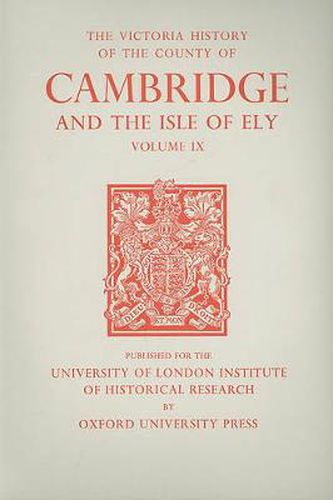Readings Newsletter
Become a Readings Member to make your shopping experience even easier.
Sign in or sign up for free!
You’re not far away from qualifying for FREE standard shipping within Australia
You’ve qualified for FREE standard shipping within Australia
The cart is loading…






THE volume relates to the part of the county lying north-west of Cambridge and includes the histories of twenty-seven parishes forming the hundreds of Chesterton, Northstowe, and Papworth. The area is bounded on the south by the road to St. Neots, on the east by the river Cam, and on the north by the Great Ouse or Old West River; it falls into two distinct physical landscapes, the land in the south sloping gently from a ridge and that in the north formingan extension of the fenlands of the Isle of Ely. Two distinct settlement patterns reflect the geographical division. The villages on the higher ground were mainly devoted to arable farming. Some of the smaller parishes there cameinto or remained in the hands of a single landowner between the early 16th and the mid 17th century, and each parish tended to be dominated by its principal landowner and the Church of England; population rose steadily in the earlier 19th century but fell sharply from the 1870s. Along the fen edge the parishes were mostly larger and included extensive meadow and pasture created on former marshland; numerous smallholders could support themselves out of theresources of the fens, grazing sheep on the commons, fishing, fowling, and cutting peat, and in the 17th century the villagers combined to resist the attempts of new lay lords to restore seigneurial rights and to inclose large tracts of commons. Religious dissent was strong. From the 1870s the establishment of orchards and market gardens and the growth of the Chivers jam factory at Histon enabled the villages to maintain or increase their population. Thesouth-east corner of the area was particularly affected by the urban and academic expansion of Cambridge in the late 19th and the 20th century; several parishes were largely built up, Chesterton became fully suburban, and research organizations were established.
$9.00 standard shipping within Australia
FREE standard shipping within Australia for orders over $100.00
Express & International shipping calculated at checkout
THE volume relates to the part of the county lying north-west of Cambridge and includes the histories of twenty-seven parishes forming the hundreds of Chesterton, Northstowe, and Papworth. The area is bounded on the south by the road to St. Neots, on the east by the river Cam, and on the north by the Great Ouse or Old West River; it falls into two distinct physical landscapes, the land in the south sloping gently from a ridge and that in the north formingan extension of the fenlands of the Isle of Ely. Two distinct settlement patterns reflect the geographical division. The villages on the higher ground were mainly devoted to arable farming. Some of the smaller parishes there cameinto or remained in the hands of a single landowner between the early 16th and the mid 17th century, and each parish tended to be dominated by its principal landowner and the Church of England; population rose steadily in the earlier 19th century but fell sharply from the 1870s. Along the fen edge the parishes were mostly larger and included extensive meadow and pasture created on former marshland; numerous smallholders could support themselves out of theresources of the fens, grazing sheep on the commons, fishing, fowling, and cutting peat, and in the 17th century the villagers combined to resist the attempts of new lay lords to restore seigneurial rights and to inclose large tracts of commons. Religious dissent was strong. From the 1870s the establishment of orchards and market gardens and the growth of the Chivers jam factory at Histon enabled the villages to maintain or increase their population. Thesouth-east corner of the area was particularly affected by the urban and academic expansion of Cambridge in the late 19th and the 20th century; several parishes were largely built up, Chesterton became fully suburban, and research organizations were established.